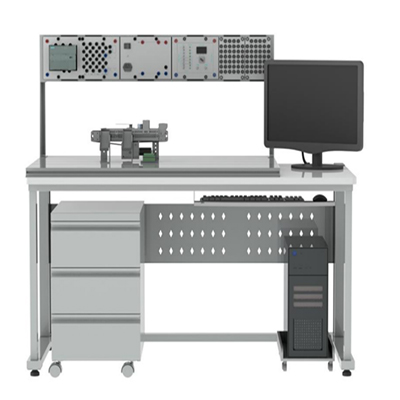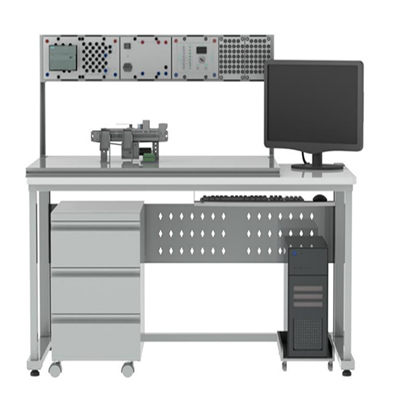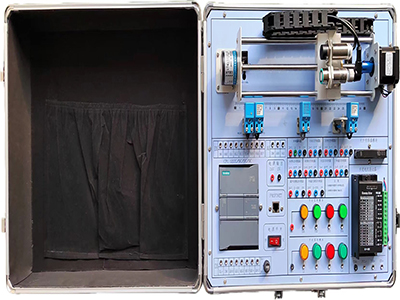The GLCG-RD industrial sensor application and detection test bench is an advanced sensor experimental teaching equipment. The teaching of industrial sensors is carried out through the self-designed model and industrial sensors. The signal detection points on the equipment are completely generated by the actual operation of the industrial control object. Students can install and debug the sensor circuit at a similar industrial debugging site, so that students can have a deep understanding of the use and detection of various sensors in industrial sites. It is an innovative teaching equipment that can train students in the application selection, fault analysis and diagnosis of industrial sensors.
GLCG-RD industrial sensor application and detection test bench
Ⅰ、General Overview
The GLCG-RD industrial sensor application and detection test bench is an advanced sensor experimental teaching equipment. The teaching of industrial sensors is carried out through the self-designed model and industrial sensors. The signal detection points on the equipment are completely generated by the actual operation of the industrial control object. Students can install and debug the sensor circuit at the similar industrial debugging site, so that students can have a deep understanding of the use and detection of various sensors in the industrial site. It is an innovative teaching equipment that can train students in the application selection, fault analysis and diagnosis of industrial sensors.
1. The table body adopts iron double-layer matte dense spray structure, and the desktop is fireproof, waterproof, wear-resistant high-density board;
2. A 900*720mm aluminum plate is placed on the top of the desktop to place fixed sensor training objects and modules, which is beautiful and generous;
3. The upper part of the training table is the training box placement area. The training box has a snap-on type, which is convenient for replacement and movement. The training box modules can be added or deleted according to customer needs;
4. There is a locked mobile cabinet under the training table for placing tools and materials;
5. The configured sensors and experimental models are close to industry and meet the training requirements of the mechatronics competition of the World Skills Competition.
6. The sensors are new sensors from well-known companies. While ensuring quality, the technology will not lag behind in a few years.
7. Configure DC power supply box, 24V/4.5A power output; short circuit protection, overload protection; snap-on design, quick disassembly and replacement;
8. Configure Siemens 1200 series PLC, CPU1215C DC/DC/DC integrated input/output: 14DI DC input 24V; 10DQ transistor output 24V DC; 2AI analog input 0-10V DC; 2AQ analog output 0-20mA DC; power supply: DC 20.4-28.8V, programmable data storage area: 125KB; 1 Siemens industrial Ethernet cable, length ≥4m;
9. Configure PLC simulation box: including 8-way switch input, 8-way switch output, 2-way analog input and 2-way analog output, configure LCD to display the size of analog input and output;
10. Configure genuine programming software, Siemens TIA Portal V16.
Ⅱ、Configuration of this industrial sensor application and detection test bench
1. Inductive sensor: composed of sensor bracket, sensor, interface unit; detection distance: 4mm±10%; detection object: magnetic metal; response frequency ≥500HZ;
2. Capacitive sensor: composed of sensor bracket, sensor, interface unit; detection distance: 1~16mm; detection object: neutral conductor;
3. Photoelectric sensor: equipped with mirror reflection sensor, opposite photoelectric sensor, diffuse photoelectric sensor, fixed on a quick disassembly base, can be connected to aluminum alloy experimental board and cable with safety plug. Working voltage: 10 – 30 V DC; light type: red light; start function: normally open contact (PNP);
4. Fiber optic sensor: structural composition: composed of sensor bracket, fiber optic sensor probe, fiber optic amplifier, interface unit. Output: can be switched by wiring or switch to select ON when light is on/ON when no light is on; equipped with short circuit protection; response time: minimum 200µs, maximum 5000µs, four levels of response time adjustable within the range; equipped with sensitivity fine-tuning function;
5. Color mark sensor: consists of sensor bracket, sensor probe and amplifier, and interface unit. Detection distance: 10±3mm; Output 1 (OUT): ① Short circuit protection: equipped (automatic reset); ② Output action: In color mode: ON when light is on/ON when no light is on (automatically set during teaching), in color mode: ON when consistent/ON when inconsistent (set during teaching); Output 2 (OUT inversion): ① Short circuit protection: equipped (automatic reset); ② Output action: Reverse operation of output 1; Response time: ≤45µs in color mode, ≤150µs in color mode; Equipped with 4-digit red LED digital display; Sensitivity setting method: In color mode: 2-point teaching/fully automatic teaching, in color mode: 1-point teaching; Equipped with sensitivity fine-tuning function;
6. Magnetoresistive sensor: The magnetoresistive proximity sensor is fixed on a quickly detachable base for use on aluminum alloy experimental boards. Working voltage: 10 – 30 V DC; Start function: Normally open contact (PNP); Output current: 200 mA; Prevent short circuit, overload and reverse polarity.
7. Material sorting sensor module
Function: Through multiple sensor signal acquisition and PLC programming, the DC reduction motor and blocking module are controlled to realize the sorting of material color and material; by controlling the extension and retraction of the cylinder, the feeding is controlled.
Structural composition: material sorting electrical module, DC reduction motor, optical fiber sensor, photoelectric sensor, experimental materials, silo, large aluminum plate, handle, aluminum profile, conveyor belt, tensioning structure, double-acting cylinder, solenoid valve, proximity switch and other technical data.
Ⅲ、Experimental content:
1. Inductive sensor experiment
2. Capacitive sensor experiment
3. Photoelectric sensor experiment
4. Optical fiber sensor experiment
5. Color mark sensor experiment
6. Magnetoresistive sensor experiment
7. Electrical circuit connection
8. Conveyor belt control experiment
9. Feeding control experiment
10. Material sorting control experiment
11. Feeding and sorting comprehensive control experiment

Synchronous PC version:
GLCG-RD industrial sensor application and detection test bench https://www.biisun.com/home/category/detail/id/132.html


 Italian
Italian German
German Russian
Russian Turkish
Turkish Portuguese
Portuguese Spanish
Spanish French
French




